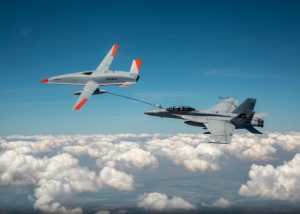The Navy successfully controlled the unmanned MQ-25A Stingray tanker aircraft on an aircraft carrier for the first time in non-flight deck handling demonstration tests aboard the aircraft carrier USS George H.W. Bush (CVN-77), the Navy said Dec. 20.
Th Navy and aircraft builder Boeing [BA] have been conducting tests for the MQ-25 with the company’s test asset, T-1, ahead of production of the first aircraft.
The T-1 arrived on the carrier on Nov. 30 to be tested with the ground control system (GCS) to evaluate the MQ-25’s system integration into a carrier environment via non-flight deck handling tests. This test was called an Unmanned Carrier Aviation Demonstration (UCAD) (Defense Daily, Dec. 6).
The MQ-25A is set to take over tanking from some F/A-18 E/F Super Hornets for aircraft based from aircraft carriers.
The Navy conducted the tests with Boeing [BA] and industry partner Lockheed Martin [LMT].
During the in-port portion of the demonstration, Lockheed Martin installed the prototype MD-5 ground control station in the CN-77’s Unmanned Aviation Warfare Center (UAWC).
The Navy said the team demonstrated the functionality of the GCS to the MQ-25 integration team, “giving them the opportunity to assess design constraints driven by shipboard installation and capture feedback on human system interfaces.”
“This was the first opportunity to have the MD-5C prototype control station installed in the UAWC. It gave the chance for leadership, test pilots, and future air vehicle operators to experience the look and feel for how the MQ-25 will operate onboard a carrier as well as inform the program office on items to consider for future UAWC layout development,” Cmdr. Karl Orthner, UCA mission control station installation lead, said in a statement.

Once the carrier was underway, the T-1 completed test points that evaluated the functionality and capabilities of the deck handling system during day and night, with maneuvers including taxiing and parking on the flight deck, connecting to the catapult and clearing the landing area.
The Navy said data was collected related to deck motion and wind over deck impacts to controllability and the propulsion system.
The team also coordinated the first Joint Precision Landing System (JPALS) surrogate flight with a Beechcraft [TXT] King Air utility aircraft.
“There is no better way to determine the success of a carrier aircraft design and its integration into the air wing then to put that new aircraft through testing at sea. I am extremely proud of our team for the stellar execution of both engine and aircraft tests, as well as the approaches flown in a surrogate aircraft. It’s an exciting time as we progress toward the air wing of the future,” Capt. Chad Reed, Unmanned Carrier Aviation program manager, said in a statement.
Ship motion data collected during these first representative hardware and software approaches will be “extremely valuable” in refining the software, Reed added.
The Navy also said during this UCAD Boeing Deck Handling Operators (DHOs) used the company’s Deck Control Device (DCD) during all phases of the deck handling system evaluation. Yellow shirt Navy taxi flight directors used standard hand signals to direct the T-1, which the operators converted into commands to the aircraft using the handheld DCD.
DHOs trained at Boeing’s deck handling simulation lab in St. Louis, where they practiced entering commands from simulated yellow shirts into the real DCD. Accordingly, a simulated MQ-25 would move accordingly.
Boeing said the DCD is an easy-to-use device specifically designed for sailors who already understand handheld technology and video game controllers.
Once fully operational, the flight director and DHOs will be able to taxi the MQ-25 on the flight deck to the catapult launch position and a parking location after landing.
While airborne, the MQ-25 is planned to be controlled from the UAWC, where the operators will execute a pre-planned mission.
“Early testing allowed our team the opportunity to evaluate many new systems for the first time at sea with T1. Our initial look at taxi operations on the flight deck successfully demonstrated the MQ-25’s ability to maneuver just like a manned aircraft in the shipboard environment,” Reed added.
“The Navy gave us two key performance parameters for the program – aerial refueling and integration onto the carrier deck. We’ve shown that the MQ-25 can meet both requirements, and we’ve done it years earlier than traditional acquisition programs,” Dave Bujold, Boeing MQ-25 program director, said in a statement.
Boeing spokeswoman Ashlee Erwin told Defense Daily the UCAD completes planned activities for the T-1 during “this phase of the program, although we continue to evaluate how we can use this test aircraft in ways that benefit the program.”
Last month, the Navy and Boeing performed deck handling ground tests of the T-1 using painted lines to section mock areas of a carrier’s flight deck (Defense Daily, Nov. 24).
Erwin said while those tests “proved to be representative” of the carrier’s constraints, the carrier-based demonstration “really tested the working relationship between the Navy yellow shirt and the deck handling operator with the device, and the team learned from that in terms of operating both day and night on a moving platform, aligning into the catapult and parking on the most challenging parts of the carrier deck, all in various wind-over-deck scenarios.”
Earlier this year, the T-1 conducted the first unmanned tanker to manned aircraft test refuelings with an F/A-18E/F Super Hornet (Defense Daily, June 7), E-2D Advanced Hawkeye (Defense Daily, Aug. 19), and F-35C Joint Strike Fighter (Defense Daily, Sept. 14).
The Navy expects the first MQ-25A engineering and manufacturing aircraft model to be delivered in the fall or winter of 2022, which will be the first aircraft to conduct the carrier-based flight tests.
Boeing was awarded an $805 million EMD contract in 2018 for the first four aircraft. The Navy plans to reach initial operational capability in 2025 and procure 72 total Stingrays (Defense Daily, Aug. 30, 2018).